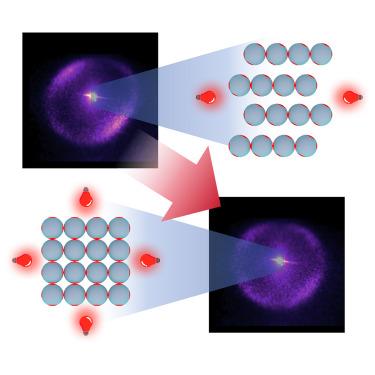动态多态活性胶体组装和光导可重构光子学
IF 17.3
1区 材料科学
Q1 MATERIALS SCIENCE, MULTIDISCIPLINARY
引用次数: 0
摘要
材料的宏观特性主要受组成其晶格的原子的精确排列所支配。最近的研究表明,光子可以激发固体的振动模式,从而诱发具有奇特性质的新相的动态转变。在这里,我们证明胶体作为微米尺度的 "原子 "对应物,也可以用光来组装,从而产生动态的材料结构和特性。这项工作使用了具有长程可调相互作用的光活性胶体粒子,这为按需引导组装提供了多用途途径。为了诱导相互作用的方向性以进行组装,利用了光活性胶体粒子上的光子纳米射流效应,以产生类似于定向分子结合的高度局部流体动力流。通过调整照明条件,可在球形胶体上产生可调定向电势,从而按需在所有二维布拉维晶格上形成多态组装。最后,我们揭示了用光控制的快速胶体相变可用于可重新配置的光子设备,以控制近红外激光的衍射。本文章由计算机程序翻译,如有差异,请以英文原文为准。


Dynamic polymorphic active colloidal assembly and optically guided reconfigurable photonics
The macroscopic properties of a material are predominantly governed by the precise arrangement of the atoms composing its crystal lattice. Recent research shows that photons can excite vibrational modes in solids that induce dynamic transitions to new phases with exotic properties. Here, we demonstrate that colloids, as a micrometer-scale “atom” counterpart, can also be assembled with light, leading to dynamic material structure and properties. This work uses photoactive colloidal particles with long-range tunable interaction, which provides a versatile route to guide assembly on demand. To induce interaction directionality for assembly, the photonic nanojet effect on a photoactive colloidal particle is exploited to create a highly localized hydrodynamic flow resembling directional molecular binding. Adjusting the illuminating condition allows the tunable directional potential to be generated on spherical colloids, forming the polymorphic assembly to all 2D Bravais lattices on demand. Finally, we reveal that the rapid colloid phase transition, as controlled with light, can be used for reconfigurable photonic devices to control the diffraction of the near-infrared laser.
求助全文
通过发布文献求助,成功后即可免费获取论文全文。
去求助
来源期刊

Matter
MATERIALS SCIENCE, MULTIDISCIPLINARY-
CiteScore
26.30
自引率
2.60%
发文量
367
期刊介绍:
Matter, a monthly journal affiliated with Cell, spans the broad field of materials science from nano to macro levels,covering fundamentals to applications. Embracing groundbreaking technologies,it includes full-length research articles,reviews, perspectives,previews, opinions, personnel stories, and general editorial content.
Matter aims to be the primary resource for researchers in academia and industry, inspiring the next generation of materials scientists.
 求助内容:
求助内容: 应助结果提醒方式:
应助结果提醒方式:


